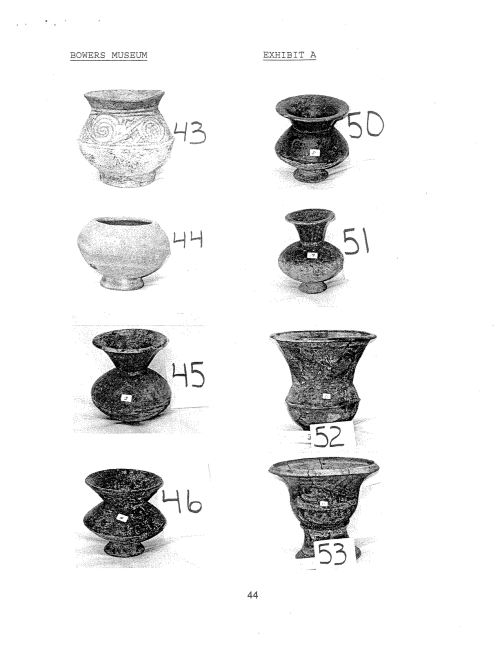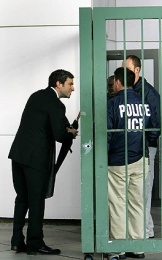
On the front page of this month’s The Art Newspaper I report that the Bowers Museum of Art has agreed to return 542 ancient vases, bowls and other artifacts to Thailand. The objects were allegedly looted from one of the most important archaeological sites in Southeast Asia and smuggled into the United States by an antiquities trafficking ring that was broken up in 2008.
The Bowers will also forfeit 71 Native American ladles were allegedly taken from federal or native lands in the United States. The Bowers acquired the ladles and Thai antiquities from Robert Olson, an alleged smuggler who I profiled in 2008. Olson has admitted buying illegally excavated objects from looters and middlemen and bragged that his collection Ban Chiang artifacts and Native American ladles were the largest in the world. He currently faces a December trial on federal charges in Los Angeles.
The returns mark additional fallout from the 2008 federal raids on several Southern California museums. (Our previous coverage can be found here.) From the story:
The returns are the result of a non-prosecution agreement between the museum and the Los Angeles US Attorney’s office stemming from federal museum raids carried out in 2008. Following a five-year undercover operation, federal agents seized hundreds of allegedly looted antiquities at the Bowers, the Pacific Asia Museum in Pasadena, the Mingei International Museum in San Diego and the Los Angeles County Museum. The authorities were investigating an alleged smuggling network that funneled looted Thai, Cambodian and Burmese artefacts into local museums, often through tax-deductible donations based on inflated appraisals, court records show.
…
In exchange for the returns to Thailand, government prosecutors agreed not to criminally charge anyone at the Bowers, the museum’s lawyer says.
“The Bowers Museum is pleased to have resolved this matter without any finding that the museum violated any law,” says Manuel Abascal. “The Bowers stopped collecting archaeological items years ago, and has instead focused on bringing important archaeological items from foreign museums to the United States for exhibition, such as the Terracotta Warriors.” Abascal says the museum had offered to return the objects years ago. “Since Armand Labbé died, it’s been in our basement. We’re more than happy to give it up,” he says. “We never conceded it was taken in an ill-gotten way.”
Most of the contested objects – many of which which are not of display quality but have cultural and archaeological importance – come from Ban Chiang, a Neolithic settlement and burial site that was continuously occupied from 1500BC to 900BC, making it one of the most important prehistoric settlements found in Southeast Asia. Thai law has claimed state ownership of all artefacts since 1961, a claim that would be recognized under American law if certain conditions are met.

Since the 2008 raids, the fate of the seized objects at the Bowers and other museums have remained in limbo while the case inches through the legal process. Last year I reported on mounting frustration that little had resulted from the dramatic federal raids.
No other museums tied to the case have returned the contested objects, though some have tried:
At the Pacific Asia Museum, 147 objects donated by various clients linked to the case remain in storage under “constructive custody” of federal authorities, a museum official said.
“The museum has not been told to return the articles,” says the interim deputy director Susana Smith Bautista. “Because [US authorities] retain ‘constructive custody’ of these works, the objects cannot leave the museum premises without written permission.”
The Mingei Museum offered to return 67 objects seized by federal authorities soon after the raids, says the museum’s attorney, Jerry Coughlan: “We have heard nothing other than a request that we continue to hold them.”
A lawyer for the Los Angeles County Museum, which has about 60 objects that were targeted in the raids, declined to comment.
The Bowers allegations were described in detailed search warrant affidavits released at the time of the raids.
The court records portray Armand Labbé, the museum’s longtime chief curator, as a willing participant in the alleged smuggling scheme, which orchestrated the donation of looted antiquities in exchange for inflated tax write-offs for donors. Labbe built much of the Ban Chiang collection with donations from clients of alleged smuggler Robert Olson, an antiquities dealer, according to the search warrant affidavits.
In a September 2003 meeting described in the affidavits, the undercover agent met Labbé at Olson’s storage locker. The curator pointed out several objects he wanted donated, and instructed the agent to pay Olson in cash for the objects and state that he had owned them for more than a year, as required to receive a tax write-off of their stated value.
Olson told the agent that he was getting objects directly from Ban Chiang, the affidavits say, and showed Labbé and the agent photos of the sites from which the objects had recently been excavated. On another occasion, Olson is alleged to have boasted that he had more Ban Chiang material than Thailand and said a client of his had donated some $250,000 worth to the Bowers.
The agent paid Olson $12,000 for the Ban Chiang objects and received an appraisal that put their value at more than $43,000. Labbé accepted that and a second donation from the agent before he died in April 2005.
In September of that year, the agent spoke with Keller, the director of the Bowers, about making a third donation. Keller said he knew Olson and had been to his warehouse, but refused to accept the donation. Labbé’s girlfriend, an appraiser, told the agent that Keller had personally donated to the museum on several occasions, the affidavits say.

Labbe presents Queen Sirikit of Thailand with a copy of his monograph, “Ban Chiang: Art and Prehistory of Northeast Thailand”, during her visit to Los Angeles.
The story details several indictments in the case that have been unsealed in recent months:
Olson was criminally indicted in 2008 along with Jonathan Markell, a Los Angeles gallery owner who arranged the donation of Ban Chiang objects to several museums. The indictment, which was only unsealed in January of this year, accused the men of one count of conspiracy to import antiquities from Burma and Cambodia and three counts of making false statements on customs forms.
In July 2003, both men allegedly travelled to Thailand to purchase the looted antiquities. The objects were listed on customs forms at 25% of their actual purchase price, and the objects were falsely described, with an ancient Burmese Buddha listed as a “wooden sitting man”, the indictment alleges.
Markell and his wife Cari were indicted in 2010 on federal tax charges that related to their alleged role in writing inflated appraisals of donations of Ban Chiang material to the museums. An attorney for Jonathan Markell declined to comment, and his wife’s attorney did not respond to a request for comment.
Olson was separately indicted in 2012 with Marc Pettibone. Pettibone is an American living in Thailand who, the indictment alleges, bought the Ban Chiang antiquities directly from “diggers” and shipped them to Olson by bribing Thai officials. Both were charged with the transportation, possession and importation of stolen antiquities.
Olson could not be reached, and his federal public defender declined to make any comment. He has previously said he bought antiquities in Thailand but did not act illegally. Pettibone, who is being sought by the authorities, could not be reached by time of going to press.
Read the complete story “Victory for Thailand in US” on The Art Newspaper’s site here. Here are copies of those recently unsealed indictments:
USA vs. Robert Olson and Jonathan Markell
USA vs. Jonathan and Cari Markell




